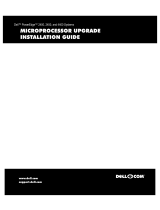
System Beep Codes
If an error that cannot be reported on the screen occurs during POST, the system may emit a series of beeps that identifies the problem.
PCIe Degraded Link Width Error: Slot n
Expected Link Width is n
Actual Link Width is n
Faulty or improperly installed
PCIe card in the specified slot
number.
Reseat the PCIe card in the specified slot number. See "Expansion Cards." If
the problem persists, see "Getting Help."
PCIe Training Error: Embedded
Bus#nn/Dev#nn/Funcn
Faulty or improperly installed
PCIe card.
Reseat the PCIe cards. See "Expansion Cards." If the problem persists, see
"Getting Help."
PCIeTrainingError:Slotn
Faulty or improperly installed
PCIe card in the specified slot
number.
Reseat the PCIe card in the specified slot number. See "Expansion Cards." If
the problem persists, see "Getting Help."
Plug & Play Configuration Error
Error encountered in
initializing PCI device; faulty
system board.
Install the NVRAM_CLR jumper and reboot the system. See FigureA-2 for
jumper location. Check for a BIOS update. If the problem persists, see
"Troubleshooting Expansion Cards" in "Troubleshooting Your System." If the
problem persists, see "Getting Help."
Read fault
Requested sector not found
Faulty diskette, diskette
drive, optical drive, or hard
drive.
Replace the diskette. Ensure that the diskette, optical, and hard-drive cables
are properly connected. See "Troubleshooting a Diskette Drive,"
"Troubleshooting an Optical Drive, "Troubleshooting SATA Hard Drives," or
"Troubleshooting SCSI Hard Drives" in "Troubleshooting Your System" for the
appropriate drive(s) installed in your system.
Remote Configuration update attempt
failed
System could not implement
Remote Configuration
request.
Retry Remote Configuration.
ROM bad checksum = address
Faulty or improperly installed
expansion card.
Remove and reseat the expansion cards. See "Troubleshooting Expansion
Cards" in "Troubleshooting Your System."
SATA Port n hard disk not found
SATA hard drive not
connected to port n.
Ensure that the hard-drive cable is properly connected. See "Cabled SATA and
SCSI Hard Drives" in "Installing Drives."
If a drive is not connected to port n, check that the SATA port is disabled in the
System Setup program. See "Using the System Setup Program" in your User's
Guide.
Sector not found
Seek error
Seek operation failed
Faulty diskette or hard drive.
Replace the diskette. If the problem persists, see "Troubleshooting SATA Hard
Drives" or "Troubleshooting SCSI Hard Drives" in "Troubleshooting Your
System" for the appropriate drive installed in your system.
Ensure that all memory modules are properly installed. See "Troubleshooting
System Memory" in "Troubleshooting Your System." If the problem persists, see
"Getting Help."
The amount of system memory has changed.
See "Troubleshooting System Memory" in "Troubleshooting Your System." If the
problem persists, see "Getting Help."
Information only, if you have
changed the memory
configuration.
The amount of tested memory is below the
minimum system configuration. System
halted!
Invalid memory configuration
or faulty memory module.
See "General Memory Module Installation Guidelines" in "Installing System
Components."
See "Troubleshooting System Memory" in "Troubleshooting Your System." If the
problem persists, see "Getting Help."
Time-of-day clock stopped
Faulty battery; faulty system
board.
See "Troubleshooting the System Battery" in "Troubleshooting Your System." If
the problem persists, see "Getting Help."
Time-of-day not set - please run SETUP
program
Incorrect Time or Date
settings; faulty system
battery.
Check the Time and Date settings See "Using the System Setup Program" in
your User's Guide. If the problem persists, see "Troubleshooting the System
Battery" in "Troubleshooting Your System."
Timer chip counter 2 failed
Unexpected interrupt in protected mode
Faulty or improperly installed
memory modules or faulty
system board.
Ensure that all memory modules are properly installed. See "General Memory
Module Installation Guidelines" in "Installing System Components." If the
problem persists, see "Troubleshooting System Memory" in "Troubleshooting
Your System." If the problem persists, see "Getting Help."
Unsupported CPU stepping detected
Processor is not supported
by the system.
Check for a BIOS update using the Dell Support website at support.dell.com. If
the problem persists, install a supported processor. See "Installing a
Processor" in "Installing System Components."
Utility partition not available
<F10> key was pressed
during POST, but no utility
partition exists on the boot
hard drive.
Create a utility partition on the boot hard drive. See "Using the Dell
OpenManage Server Assistant CD" in your User's Guide.
Warning! No microcode update loaded for
processor n
Update the BIOS firmware using the Dell Support website at support.dell.com.
Write fault
Write fault on selected drive
Faulty diskette, diskette
drive, optical drive, hard
drive.
Replace the diskette. Ensure that the diskette drive, optical drive, and hard-
drive cables are properly connected. See "Troubleshooting a Diskette Drive,"
"Troubleshooting an Optical Drive," or "Troubleshooting SCSI Hard Drives" in
"Troubleshooting Your System" for the appropriate drive(s) installed in your
system.




















